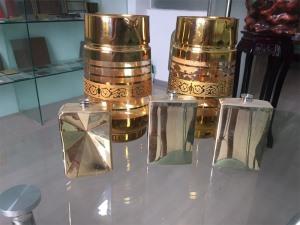Guangzhou Tianmai Chemical Technology Co., Ltd. mainly produces and manages related chemical materials such as glass ink, glass paint, metal paint, floor paint and water-based paint. Its brands: “Tianmai Tomy” and “CashCow's likes” have been well received by the market. The company takes the construction of corporate culture as its core competitiveness, and it is full of ambition and ambition. It is determined to be high-spirited and vomiting new products. In the coating industry, it leads the trend and leads the future.
For non-metallic matrix materials, there is no uniform method for surface treatment before electroplating because of the speciality of electroplating varnish. It is necessary to pre-plating pre-plating according to the characteristics of different non-metallic materials and electroplating requirements. In order to obtain a good performance coating.
In the quality inspection of electroplating varnish products, it is often found that some plating drops, bubbling or spotting, and some uncoated layers. The reason is that most of the cases are due to poor pre-plating treatment of the base material.
Electroplating is an electrochemical reaction that occurs between the interface of the substrate to be plated and the interface of the plating solution. In order to ensure the quality of the plating layer, the surface of the part to be plated that is touched with the plating liquid must be the base material itself.
In order to reduce the wear of some parts, it is necessary to use a chrome layer with a loose hole. Not only is it not afraid of the holes in the coating, but it is consciously trying to deepen the pores and texture on the chrome layer. If it is selectively plated under the laser effect, it can only form a certain thickness of plating in a small area of the laser. Substantially no plating occurs in the surrounding portion.
It means that the surface of the parts to be plated cannot contain any grease or other contaminants, and there should be no other layers of rust products, and the surface of the parts should be flat and lubricated. In this way, the surface of the substrate material is well wetted by the plating solution, and the plated metal can be firmly bonded to the surface of the flat lubricating base material. It can be seen that the importance of pre-treatment preparation of the surface of the metal matrix material before electroplating is unquestionable.

Related Industry Knowledge
- Floor paint construction acceptance standard floor paint construction plan
- Characteristics and construction technology of glass wine bottle paint
- Process difference and advantages and disadvantages of vacuum electroplating varnish and water electroplating varnish
- Waterborne metal baking paint spraying precautions
- About the construction of water-based glass bottle paint
- What are the problems with the epoxy floor paint in the underground parking lot?
- Double propylene polyurethane sealant construction process and precautions
- The difference between art floor and epoxy floor Guangzhou Tianmai supply high quality floor paint
- Several points that must be known before the construction of self-leveling epoxy floor paint
- Waterborne metal paint has become a mainstream product in the waterborne coating industry.
- Introduction and application of colored wear-resistant pavement coating
- What are the advantages of colored wear-resistant pavement coatings?
- Which is better for water-based glass paint and oil-based glass paint?
- Take your considerations for analyzing waterborne metallic paints

